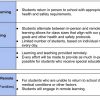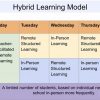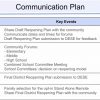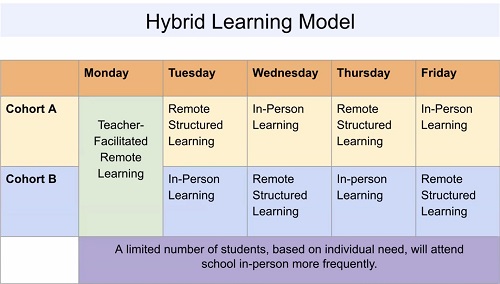Above: Parents are just beginning to learn about a K-8 recommended Hybrid Model for reopening schools. Emails will go out Friday and forums will be held next week. (image cropped from zoom webinar)
Last night, the K-8 School Committees for Northborough and Southborough heard the administration’s plans for reopening school in September. In the meeting, the administrative team recommended a Hybrid Model as the best option. The newly unveiled version would put most kids in schools only two days per week. The plan is touted as the most effective way to safely educate students over the coming school year.
 The model is one of 4 plans the district is submitting to the Dept of Elementary and Secondary Education as required. The School Committees won’t vote how to proceed until after community forums are held for the public next week.
The model is one of 4 plans the district is submitting to the Dept of Elementary and Secondary Education as required. The School Committees won’t vote how to proceed until after community forums are held for the public next week.
I was unable to watch the full meeting last night, so I can only share some highlights at this point. Look for the full details in an email to parents this Friday.
Superintendent Gregory Martineau said that in talking with many teachers, they believe that returning kids to classroom is important for their well being. But they are also concerned about their own personal safety.
The districts would be able to meet state standards for a 100% In-Person Model. The state requires 3 feet of distance between students. But, the district has higher safety standards. They are looking to keep students seated 6 feet apart. The Hybrid Model would allow for that, but the 100% version wouldn’t.
Assistant Superintendent Stephanie Reinhorn also described the 100% In-Person Model as not conducive to learning. She opined that the rows of students in masks and teacher in the front with no room for movement each day would feel too constricting to students. She reiterated that (and the safety issue) when asked if the district considered having just K-3 students attend for 100% In-Person learning.
Whichever model the schools adopt this year, including Full Remote Learning, they will be very different from education in the spring. Come September, students will be scheduled to participate in a full school days worth of learning (from 8:30 am – 2:30 pm or 9:00 am – 3:00 pm). This year, students will be graded, and educators are expected to meet the school’s normal curriculum standards.
That doesn’t mean that kids will be staring at screens all day. Reinhorn expects students to alternate between on screen and off screen tasks – as well as taking breaks, including for lunch.
The learning models was only one aspect of the long meeting. A lot of time was also dedicated to safety protocols for returning to schools. That includes requirements for students to use two masks per day, hand sanitizers at entrances for people entering and leaving buildings, and a detailed rule list to follow if someone exhibits symptoms of Covid-19. Time was also dedicated to how educators will work with students with IEPS and English as Second Language Learners, Food Services, Transportation issues, and more. (New bus guidelines from the state cap one student per 3-person bench seat, except for siblings who can sit together.)
I missed too many of those details, so I’ll just focus on the learning models below.
Under DESE requirements, the Hybrid Model or 100% In-Person Model would be partnered with a Stand Alone Remote Learning Model. The Stand Alone model allows families to opt out of sending kids to school. Many details for the remote learning under both models are still being worked out.
Reinhorn noted that the number of families who choose the Stand Alone version would make a big planning impact. She said that planning for 20% of students would be different than for 5% of students. In a prior survey, 7% of respondents said they wouldn’t send kids to a Hybrid Model and 17% said they were undecided. Martineau agreed with School Committee members who believed that a new survey is needed.
The new Hybrid Model was adapted since the version shared with parents earlier this summer. The schedule change deals with two issues: consistency and full classroom connections.
 Parents and teachers had indicated a preference for having students alternate days. The feedback is that it would keep kids more engaged through greater consistency and more frequent in-person teaching. A downside to the original model was an alternating weekly schedule. (Mon, Wed, Fri, Tues, Thurs, then around again.) Parents were concerned it would be difficult to follow the schedule.
Parents and teachers had indicated a preference for having students alternate days. The feedback is that it would keep kids more engaged through greater consistency and more frequent in-person teaching. A downside to the original model was an alternating weekly schedule. (Mon, Wed, Fri, Tues, Thurs, then around again.) Parents were concerned it would be difficult to follow the schedule.
According to Reinhorn, the planning team also believed it was important for teachers to regularly work with full classes. The new model has teachers facilitating Remote Learning on Mondays with their full classes. Then on Tuesday through Friday, students alternate in-classroom learning on a set weekly schedule.
The alternating days will allow teachers to send kids home with the materials and resources they need for Remote Learning days. (The hope is that will alleviate parent’s burdens for helping kids, vs the remote model that was held in the spring.)
The alternating “cohorts” would be determined by last name (to keep families on the same schedule), and wouldn’t allow parents to ask for exceptions based on their schedules. Some students would be selected as exceptions that need to attend school more frequently.
Families that opt for the Stand Alone option would be allowed to change their minds mid-year. But they may need to wait for a “strategic” time to be shifted into a classroom.
Since students’ teachers would be leading classrooms in the Hybrid Model, they wouldn’t be the ones facilitating remote learning on Tuesdays – Fridays. The administration is still working out details for how students would stay engaged from home during school hours. Options include streaming the classroom and utilizing dedicated staff.
Reinhorn expects some teachers with underlying health conditions will only work from home. Those teachers and other special assistants may be ones engaging in online sessions with students. Teachers would also work in teams to split work creating videos to be viewed and sharing vetted outside resources.
Stand Alone Remote Learning students will be invited to participate in any extra-curricular or school-wide activities that are held virtually for in-person learners. The program may incorporate some state options. (Those details are yet to be released.) Virtual classrooms may also pull together students from multiple schools. The district is looking at the possibility of teaming with other towns, but Reinhorn referred to that option as having a lot of layers. She quipped, it would be a large project if there was no other project on our plate.
Reinhorn said one priority at the start of school, regardless to which model is followed, is devoting time to making connections and building community, routines, and a foundation on which learning can happen. She also noted that teachers will have to assess where students are and “meet them there” to help them progress in learning.
Although pushing for the Hybrid Model, the administration is also working to ensure that a Full Remote Model is developed enough to quickly pivot to it if needed. Reinhorn said that if they need to shift, they don’t want to lose even one day of school.
The chat and Q&A on the zoom call was inundated with parent questions. Some were addressed but not all. Northborough’s K-8 Chair Kieth Lebel wrote and stated:
Hi All, We are glad to see so many engaged participants and lots of good questions. I’m summarizing a few things regarding the process at this point. This meeting was not intended to be a community forum, but, with the technology at hand (the webinar format w/ Q&A), it started to turn into one. So, what we are doing is capturing every question submitted. We will do one or both of the following: publish an FAQ, hold a community forum or public hearing/webinar. There are 93 open questions at the moment, many overlapping and all unsorted by type. It will be quite inefficient if we take those line by line today. So we instead pledge to take those on follow-up. This is also stated in similar form on this meeting’s agenda. This is a complex issue with a lot of information, evolving quickly, so we’ll need to handle this in a series of phases/communications. Thank you for your patience and understanding!
 Superintendent Gregory Martineau followed with his communication plan. He pledged sending draft plans to parents this Friday, along with a schedule for forums.
Superintendent Gregory Martineau followed with his communication plan. He pledged sending draft plans to parents this Friday, along with a schedule for forums.
Last night’s meeting didn’t include the Regional Committee for Algonquin Regional High School. That committee is scheduled to hear plans on Friday morning.
Three Community Forums will be held for Elementary, Middle, and High School next week. Later that week, the Combined School Committees are expected to make a decision. The administration is expecting some feedback from DESE in time to submit final plans to DESE by August 10th. That week, families would be asked to make a decision about whether to participate in the district’s standard or Stand Alone model.
As for the youngest district students, the district plans to follow a 100% In-Person model for the Pre-K program.
If the Hybrid Model is adopted—what will parents do who can’t work from home but have children too young to leave alone?
I don’t know of any free options at this time. I can share that SkyRise Theatre is promoting options for having kids do their work under tutor supervision. You can check that out here. If anyone has other tips, feel free to share in the comments.



This is so disappointing. The hybrid model is a fear-based choice. The data in Massachusetts clearly shows that we are ready for 100% In Person schooling.
If the district is capable of supporting a 100% In Person model, then that is what the mental health, social wellbeing, and overall education of our children require.
The reason we are doing so well in Massachusetts is that we are being careful, following the rules, wearing masks, distancing, etc. Filling buses, classrooms, and cafeterias to full capacity is exactly the opposite of that. I believe if we went to full schools again, we’d probably end up having to fully close them again soon.
The issue is there are no great answers. We have to do the best we can. Hybrid is essentially the best out of a group of less-than-ideal choices.
Hate to disagree Tim. It was obvious that school would not be re-opening months ago. The teachers unions across the state and the country will make sure of it.
The fact is that very few people are willing to consider the real risks of not opening up schools 100% creates far more harm to our community. Unfortunately, people are way too afraid to ask real questions out loud and will conform without thinking for themselves.
Not to worry Tim, our school committee members will ask tough questions, seek a better solutions and make sure these solutions are implemented. OK, this won’t happen, but hope springs eternal.
One of these days the public will wake up to the control the teacher’s union has on the school system.
I hope that everyone continues to listen to science. I agree with “southville” that the only reason that our rates are down is that we have been cautious and respectful for the most part in Massachusetts. We need to continue to do so until we have a vaccine or effective treatments for this virus. Almost everyone agrees that children should be in school, but we have to balance that with the fact that we are in the midst of a global pandemic with national leadership that has failed us miserably. So please let’s not blame the teachers union and “scaredy cats.”
Beth,
Can you clarify this statement, ” A downside to the original model was an alternating weekly schedule. (Mon, Wed, Fri, Tues, Thurs, then around again.) Parents were concerned it would be difficult to follow the schedule.”
It seems apparent that an every other week schedule would promote greater safety…. Fewer kids would be in the buildings each week.
I must admit I am shocked and dismayed by the sense of urgency in returning kids to school. We are in the midst of a PANDEMIC. Can we not take a PAUSE until things settle down?
Right now it looks like home schooling is the way to go and I’m glad to see that as an option.
Your question points out that the wording I used was confusing. I was referring to the hybrid model that I noted before that sentence “Parents and teachers had indicated a preference for having students alternate days”. The model that they originally presented for alternating days of attending school was also different on alternating weeks. Week 1 kids would go to school or stay home on Mon, Wed, and Friday, then the next week it would flip to the reverse schedule. Feedback had indicated that would be difficult to keep track of.
As for the safety of kids in school per week – one detail I didn’t include in the post was that they said the school would be “deep” cleaned each day.
Does anyone have information on what other schools are doing? For example, Framingham? I believe it’s all remote….. Westford? Completely remote is what has been in favor. It would be interesting to examine other districts and their choices before committing to something prematurely here in Southborough. And what about Fay and St. Marks?
Marlboro is opening with hybrid model per Friday’s Middlesex News.
Framingham plans to open as Full Remote for several weeks with a migration to hybrid sometime in October…. same source.
I have heard that Worcester is opening with hybrid model, but have not read it in any news source.
It’s also been reported ( Boston Globe ) that the Boston and Lexington Superintendents prefer hybrid.
No info on Fay or St Mark’s that I’ve seen but i’d suggest that their campuses and classrooms may allow much easier ‘distancing’ within classrooms than any public facility. I’d also speculate that their dorms won’t be filled… Not sure I’d send my kid to the US for school right now…
Most teachers unions seem to favor Full Remote.
100% in-person could be done with some creativity and with better priorities. Classes could be held outside whenever possible; there is extensive open space outside of the schools. Gyms and cafeterias could be converted into additional classrooms. Other public buildings could be converted as well. Countries like Denmark have had success with that approach.
Younger children especially have trouble with distance learning. Neighboring towns like Marlboro have taken this into account and have full time learning for K-2. The dismissal of the full time option for younger children in Southborough is mystifying.
Children have taken the brunt of the shutdown. They had to leave school first, numerous camps were cancelled, and we prioritized things like casinos, gyms, indoor dining, and golf courses over them.
Do not discount the importance of school to working parents; many do not have the luxury of working from home, and the expense of childcare is great. Those who can afford it will hire tutors and nannies to watch their kids, likely pooling their resources to do so. That will cause more close contact between families who are sharing childcare, undermining the health considerations driving a hybrid model. Of course this pushes families who can’t afford alternative care into increasingly impossible positions.
If there is a medical profession in the community with an expertise in infectious diseases, would you please provide your opinion. Here’s the scenario, you have one group of students in a building on one day. The building then needs to be sanitized. Another group of students will be in the building the following day…The building needs to be sanitized…. Back and forth. Whatever germs are in the building on day will likely still be there on the following day when there is an entirely different group of students….
Or, there is one group of students in the building for 4 consecutive days and then there’s a weekend (or possibly even 3 days in between) and then a different group of students in the following week……
It’s a simple question that I hope someone can answer with documentation.
It may be that we have put the convenience factor above the safety factor and I would like assurance that that is NOT the case.
And, yes, I am concerned about the prospect of my children contracting the virus and bringing it home. I would prefer not to spend time fighting for my life in a hospital with the potential of never seeing my children again. I can wait a few months until everything calms down with respect to what is going on across the country with the covid-19 virus..
Sincerely,
Diane Romm, PhD
Here you go.
https://www.nejm.org/doi/full/10.1056/NEJMms2024920
Conclusions (from the NEJM article):
Whether (and how) to reopen primary schools is not just a scientific and technocratic question. It is also an emotional and moral one. Our sense of responsibility toward children — at the very least, to protect them from the vicissitudes of life, including the poor decision making of adults who allow deadly infections to spiral out of control — is core to our humanity. Our expectations of school personnel are equally emotionally and morally fraught. It is not incidental that the majority of primary school teachers are undercompensated women who are expected to sacrifice themselves “for the sake of the children.” School closures have also brought social, economic, and racial injustice into sharp relief, with historically marginalized children and families — and the educators who serve them — suffering the most and being offered the least. For all these reasons, decisions about school reopenings will remain complex and contested.
But the fundamental argument that children, families, educators, and society deserve to have safe and reliable primary schools should not be controversial. If we all agree on that principle, then it is inexcusable to open nonessential services for adults this summer if it forces students to remain at home even part-time this fall.